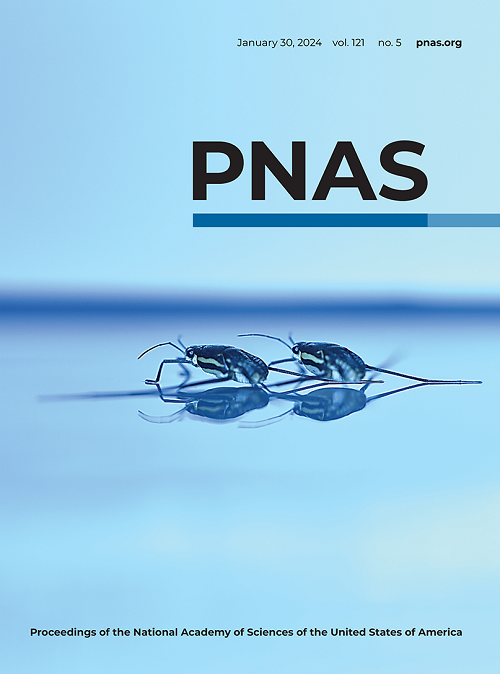病毒坏死体介导RIPK3直接激活,促进炎症性坏死
IF 9.4
1区 综合性期刊
Q1 MULTIDISCIPLINARY SCIENCES
Proceedings of the National Academy of Sciences of the United States of America
Pub Date : 2025-05-27
DOI:10.1073/pnas.2420245122
引用次数: 0
摘要
坏死坏死是一种炎症性程序性细胞死亡途径,由RIPK3通过一种上游含rhm结构域的蛋白(包括RIPK1、TRIF和ZBP1)激活引发。坏死下垂是否可以独立于导致炎症发病的上游信号通路而被激活尚不清楚。在这里,我们揭示了一种病毒蛋白介导RIPK3直接激活导致患者严重炎症发病的机制。一种致病性出血性病毒SFTSV的非结构蛋白NSs与RIPK3激酶结构域相互作用,形成生物凝聚物,以一种不依赖于rhm的方式促进RIPK3自磷酸化和坏死坏死活化。同时,在NSs-RIPK3凝聚物中隔离RIPK3可以抑制RIPK3介导的细胞凋亡,促进病毒复制。感染SFTSV不形成NSs凝聚体的NSs突变病毒可引起明显的细胞凋亡,从而减少病毒复制和降低体内致死率。通过消耗MLKL或用ripk3激酶抑制剂治疗来阻断sftsv引发的坏死性上睑下垂,可以减少体内病毒炎症的发病机制和致死率。相比之下,通过耗尽RIPK3来阻断sftsv触发的细胞凋亡导致病毒复制增强和体内死亡率增加。病毒引发的坏死性上睑下垂与病毒感染患者的严重炎症发病机制和致死率相关。NSs-RIPK3凝聚物可能代表了一种促进病毒发病的坏死下垂激活机制。本文章由计算机程序翻译,如有差异,请以英文原文为准。
A viral necrosome mediates direct RIPK3 activation to promote inflammatory necroptosis
Necroptosis is an inflammatory programmed cell death pathway triggered by RIPK3 activation through one of the upstream RHIM-domain-containing proteins including RIPK1, TRIF, and ZBP1. Whether necroptosis can be activated independent of the upstream signaling pathways leading to inflammatory pathogenesis remains ambiguous. Here, we revealed a mechanism in which a viral protein mediates direct RIPK3 activation resulting in severe inflammatory pathogenesis in patients. The nonstructural protein NSs of a pathogenic hemorrhagic virus, SFTSV, interacts with the RIPK3 kinase domain and forms biocondensate to promote RIPK3 autophosphorylation and necroptosis activation in an RHIM-independent manner. In parallel, sequestration of RIPK3 within the NSs–RIPK3 condensate inhibited RIPK3-mediated apoptosis and promoted viral replication. Infection with an SFTSV NSs mutant virus not forming NSs condensate triggered pronounced apoptosis resulting in reduced viral replication and decreased fatality in vivo. Blocking SFTSV-triggered necroptosis through depletion of MLKL or treatment with a RIPK3-kinase inhibitor reduced viral inflammatory pathogenesis and fatality in vivo. In contrast, blocking SFTSV-triggered apoptosis through depletion of RIPK3 resulted in enhanced viral replication and increased fatality in vivo. The virus-triggered necroptosis correlated with severe inflammatory pathogenesis and lethality in virus-infected patients. The NSs–RIPK3 condensate may represent a necroptosis activation mechanism that promotes viral pathogenesis.
求助全文
通过发布文献求助,成功后即可免费获取论文全文。
去求助
来源期刊
CiteScore
19.00
自引率
0.90%
发文量
3575
审稿时长
2.5 months
期刊介绍:
The Proceedings of the National Academy of Sciences (PNAS), a peer-reviewed journal of the National Academy of Sciences (NAS), serves as an authoritative source for high-impact, original research across the biological, physical, and social sciences. With a global scope, the journal welcomes submissions from researchers worldwide, making it an inclusive platform for advancing scientific knowledge.

 求助内容:
求助内容: 应助结果提醒方式:
应助结果提醒方式:


